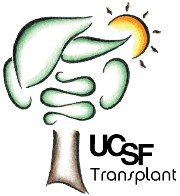UCSF Kidney, Liver and Lung Transplant Programs Earn Highest SRTR Score for Risk Adjusted Outcomes
 Becker's Hospital Review reports that the UCSF Kidney, Liver, and Lung Transplant Programs each received the highest score "5", "Better than Expected" for transplant outcomes*, based on the most recent data from the Scientific Registry of Transplant Recipients (SRTR). These scores were evaluated using SRTR's new "5-Tier Outcome Assessment".
Becker's Hospital Review reports that the UCSF Kidney, Liver, and Lung Transplant Programs each received the highest score "5", "Better than Expected" for transplant outcomes*, based on the most recent data from the Scientific Registry of Transplant Recipients (SRTR). These scores were evaluated using SRTR's new "5-Tier Outcome Assessment".
The number of organ transplants performed in the U.S. hit a record high in 2016, with 33,606 transplants performed, according to the United Network for Organ Sharing. But not all transplant centers were created equal — some have much better patient outcomes than others.
Using data collected from other organizations, the Scientific Registry of Transplant Recipients assesses outcomes of centers that perform liver, heart, lung, kidney and kidney-pancreas transplants. According to SRTR, it uses a risk-adjusted assessment to evaluate how often patients are alive with a functioning transplanted organ one year after the transplant and then assigns a score of one (the worst) to five (the best).
The SRTR outcomes assessment is a risk-adjusted assessment evaluating how often patients are alive with a functioning transplanted organ 1 year after transplant. Among those institutions comprising the highest ranked group for the most recent SRTR 1-year reporting period, using the SRTR's new "5-Tier Outcome Assessment", UCSF Medical Center:
- Performed the largest number of adult kidney transplants, 298.
- Performed the largest number of adult liver transplants,159.
- Performed the largest number of adult lung transplants in the state of California, 61.
Related Link
These 53 Hospitals have the Best Organ Transplant Outcomes - Becker's Hospital Review
About the Programs
Kidney Transplant
The UCSF Connie Frank Transplant Center provides care for patients before and after kidney and pancreas transplants. Patients requiring a kidney transplant suffer from end-stage renal disease. Most patients needing a pancreas transplant suffer from type 1 diabetes. Usually patients needing a pancreas are also in need of a kidney transplant.
Established in 1964, our program serves as a major transplant center for the West. Our kidney team evaluates over 1,000 patients a year as potential transplant candidates, and performs more than 325 transplants a year. In 2015, we performed more kidney and kidney/pancreas transplants than any other program in the U.S., according to data from the Organ Procurement and Transplant Network.
Liver Transplant
The UCSF Liver Transplant Program has performed more than 3,000 liver transplants for adults and children since it began in 1988.
The program, designated as a "Center of Excellence" by the U.S. Department of Health and Human Services, is recognized as one of the nation's leading centers for pediatric and adult liver transplants. We perform more liver transplants than any other hospital in Northern California, and more living donor liver transplants than any other program in the nation.
Adults, who receive transplanted livers from living and deceased donors at UCSF Medical Center, have a one-year survival rate that consistently exceeds the national average, according to the Scientific Registry of Transplant Recipients (SRTR), which maintains a national database of statistics related to organ transplants.
Lung Transplant
Lung transplant is the most advanced treatment for patients with severe diseases of the lung, such as emphysema, cystic fibrosis, pulmonary fibrosis and pulmonary hypertension, to name a few. U.S. News & World Report named UCSF Medical Center's Lung Transplant Program a specialized center of excellence for treating cystic fibrosis and pulmonary hypertension.
Our lung transplant program has performed more than 500 transplants, mostly bi-lateral, since the program began in 1991. The transplant program has established a reputation for accepting and transplanting challenging, complex patients. Despite this, UCSF is currently the top lung transplant program in the country for higher than expected patient survival rates and graft survival rates (survival of the transplanted lungs), according to data compiled by the Scientific Registry of Transplant Recipients. We are the only program to maintain this status two years in a row.
